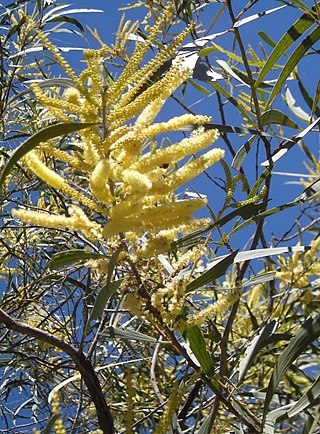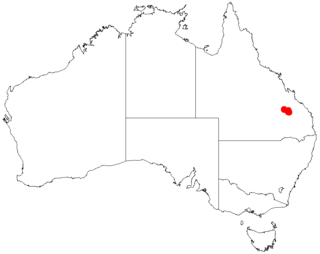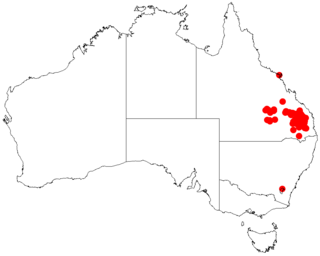
Acacia cultriformis, known as the knife-leaf wattle, dogtooth wattle, half-moon wattle or golden-glow wattle, is a perennial tree or shrub of the genus Acacia native to Australia. It is widely cultivated, and has been found to have naturalised in Asia, Africa, North America, New Zealand and South America. A. cultriformis grows to a height of about 4 m (13 ft) and has triangle-shaped phyllodes. The yellow flowers appear from August to November in its natural range. Its attractive foliage and bright flowers make it a popular garden plant.

Acacia pycnantha, most commonly known as the golden wattle, is a tree of the family Fabaceae. It grows to a height of 8 metres and has phyllodes instead of true leaves. The profuse fragrant, golden flowers appear in late winter and spring, followed by long seed pods. Explorer Thomas Mitchell collected the type specimen, from which George Bentham wrote the species description in 1842. The species is native to southeastern Australia as an understorey plant in eucalyptus forest. Plants are cross-pollinated by several species of honeyeater and thornbill, which visit nectaries on the phyllodes and brush against flowers, transferring pollen between them.

Acacia melanoxylon, commonly known as the Australian blackwood, is an Acacia species native to south-eastern Australia. The species is also known as blackwood, hickory, mudgerabah, Tasmanian blackwood, or blackwood acacia. The tree belongs to the Plurinerves section of Acacia and is one of the most wide-ranging tree species in eastern Australia and is quite variable mostly in the size and shape of the phyllodes.

Acacia aulacocarpa, also known as New Guinea wattle or golden flowered salwood, is an Australian shrub or tree in the family Fabaceae. It is found in northern Australia, Papua New Guinea, Irian Jaya and parts of Indonesia.

Acacia floribunda is a perennial evergreen shrub or tree. It is a species of wattle native to New South Wales, Queensland and Victoria, but is cultivated extensively, and has naturalised in South Australia, Tasmania and Western Australia, and also in Indonesia, Mauritius and northern New Zealand. Common names for it include gossamer wattle, weeping acacia and white sallow wattle. It grows up to 6m in height, but there is a commercial form available which only grows to about 1m tall. Its cream-colored flowers occur in the early Spring.

Acacia longifolia is a species of Acacia native to southeastern Australia, from the extreme southeast of Queensland, eastern New South Wales, eastern and southern Victoria, southeastern South Australia, and Tasmania. Common names for it include long-leaved wattle, acacia trinervis, aroma doble, golden wattle, coast wattle, sallow wattle and Sydney golden wattle. It is not listed as being a threatened species, and is considered invasive in Portugal, New Zealand and South Africa. In the southern region of Western Australia, it has become naturalised and has been classed as a weed by out-competing indigenous species. It is a tree that grows very quickly reaching 7–10 m in five to six years.

Acacia penninervis, commonly known as mountain hickory wattle, or blackwood, is a perennial shrub or tree is an Acacia belonging to subgenus Phyllodineae, that is native to eastern Australia.

Acacia brunioides, commonly known as brown wattle is a species of flowering plant in the family Fabaceae and is endemic to eastern Australia. It is an erect or spreading shrub with more or less cylindrical phyllodes, inflorescenses arranged singly in leaf axils, each with 20 to 27 more or less white to bright yellow flowers, and straight, papery to leathery pods up to 15–60 mm (0.59–2.36 in) long.

Acacia podalyriifolia is a perennial tree which is fast-growing and widely cultivated. It is native to Australia but is also naturalised in Malaysia, Africa, India and South America. Its uses include environmental management and it is also used as an ornamental tree. It is very closely related to Acacia uncifera. It grows to about 5 m in height and about the same in total width. It blooms during winter.

Acacia concurrens, commonly known as curracabah or black wattle, is a shrub native to Queensland in eastern Australia.

Acacia leiocalyx grows in Queensland, Australia and as far south as Sydney. It is widespread and common in eucalypt woodlands, especially on well-drained, shallow soils. It is short-lived and grows 6–7 metres (20–23 ft.) tall, with a trunk about 180 mm in diameter.

Acacia macradenia is also known as the zig-zag wattle, which derives from its zig-zag stem growth pattern. Another name used to identify A. macradenia is the 'bed of rivers'. Distinguishing features include alternating phyllodes, yellow globular clusters growing at the forks of the branches and a 'zig-zag' stem.

Acacia aciphylla is a species of flowering plant in the family Fabaceae and is endemic to the south-west of Western Australia. It is a bushy, prickly shrub with down-turned, rigid, sharply-pointed phyllodes, flowers arranged in a oval heads usually arranged in pairs in leaf axils, and linear pods up to 90 mm (3.5 in) long.

Acacia jibberdingensis, also known as Jibberding wattle or willow-leafed wattle, is a shrub or tree belonging to the genus Acacia and the subgenus Juliflorae that is endemic to Western Australia.
Acacia seclusa, commonly known as saw range wattle, is a small tree belonging to the genus Acacia and the subgenus Juliflorae that is endemic to northern Australia.

Acacia dictyophleba, also known as the sandhill wattle, waxy wattlefeather veined wattle, and spear tree, is a shrub belonging to the genus Acacia and the subgenus Phyllodineae. The Nyangumarta peoples know the plant as Langkur or Lungkun; the Thalanyji know it as Jabandi; and the Pintupi know it as mulyati.

Acacia falciformis, also commonly known as broad-leaved hickory, hickory wattle, mountain hickory, large-leaf wattle, tanning wattle and black wattle, is a shrub belonging to the genus Acacia and the subgenus Phyllodineae that is endemic to eastern Australia

Acacia hockingsii, also known as Hocking's wattle, is a shrub belonging to the genus Acacia and the subgenus Phyllodineae that is native to parts of north eastern Australia.

Acacia juncifolia, commonly known as rush-leaf wattle, is a shrub or tree belonging to the genus Acacia and the subgenus Phyllodineae that is endemic to north eastern Australia.

Acacia pustula is a tree belonging to the genus Acacia and the subgenus Phyllodineae native to north eastern Australia.





























